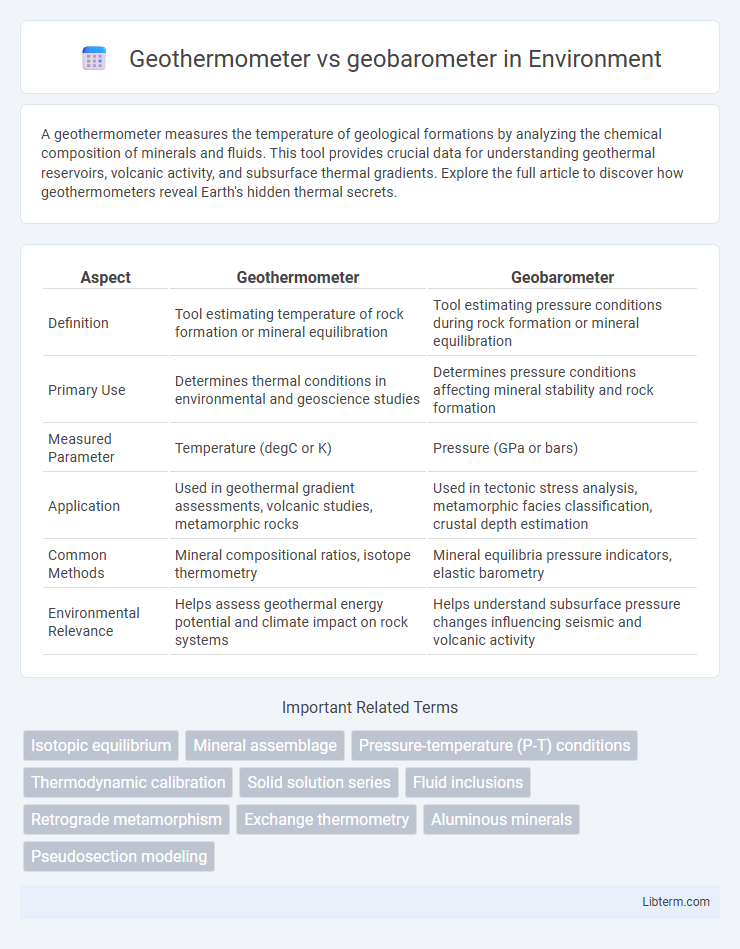A geothermometer measures the temperature of geological formations by analyzing the chemical composition of minerals and fluids. This tool provides crucial data for understanding geothermal reservoirs, volcanic activity, and subsurface thermal gradients. Explore the full article to discover how geothermometers reveal Earth's hidden thermal secrets.
Table of Comparison
| Aspect | Geothermometer | Geobarometer |
|---|---|---|
| Definition | Tool estimating temperature of rock formation or mineral equilibration | Tool estimating pressure conditions during rock formation or mineral equilibration |
| Primary Use | Determines thermal conditions in environmental and geoscience studies | Determines pressure conditions affecting mineral stability and rock formation |
| Measured Parameter | Temperature (degC or K) | Pressure (GPa or bars) |
| Application | Used in geothermal gradient assessments, volcanic studies, metamorphic rocks | Used in tectonic stress analysis, metamorphic facies classification, crustal depth estimation |
| Common Methods | Mineral compositional ratios, isotope thermometry | Mineral equilibria pressure indicators, elastic barometry |
| Environmental Relevance | Helps assess geothermal energy potential and climate impact on rock systems | Helps understand subsurface pressure changes influencing seismic and volcanic activity |
Introduction to Geothermometers and Geobarometers
Geothermometers and geobarometers are essential tools in geoscience used to estimate the temperature and pressure conditions during rock formation. Geothermometers analyze mineral compositions and chemical equilibria to determine the thermal history of rocks, while geobarometers use mineral assemblages and phase relationships to infer the pressure environment. Accurate interpretation of these instruments enables reconstruction of metamorphic and magmatic processes within the Earth's crust and mantle.
Fundamental Principles of Geothermometry
Geothermometry relies on the temperature-dependent equilibrium of mineral compositions to estimate the temperature at which rocks or fluids formed, using chemical reactions sensitive to thermal conditions. This method quantifies temperature by analyzing mineral assemblages or isotopic ratios, providing precise thermal histories essential for understanding metamorphic and igneous processes. Unlike geobarometry, which focuses on pressure estimation through mineral phase equilibria, geothermometry directly links compositional changes to temperature variations in geological systems.
Basic Concepts in Geobarometry
Geobarometers estimate the pressure conditions during rock formation by analyzing mineral equilibria, providing insights into the depth of metamorphism. Geothermometers measure the temperature of mineral formation through chemical composition changes, focusing primarily on thermal conditions. Basic concepts in geobarometry involve pressure-sensitive mineral reactions and their equilibrium constants to determine the pressure at which metamorphic minerals formed.
Geological Significance of Geothermometers
Geothermometers are essential geological tools that estimate the temperature of mineral formation by analyzing the chemical composition of rocks and minerals, providing critical data for understanding geothermal gradients and metamorphic conditions. Unlike geobarometers, which determine pressure conditions, geothermometers specifically reveal thermal histories that influence metamorphic reactions and magmatic processes. Accurate temperature measurements from geothermometers assist in reconstructing tectonic environments and evaluating geothermal energy potential with greater precision.
Geological Applications of Geobarometers
Geobarometers provide precise pressure estimates in metamorphic rocks, enabling reconstruction of tectonic processes and crustal evolution. These tools are crucial for determining depth conditions during mineral formation, which aids in interpreting orogenic events and mantle-crust interactions. Geothermometers complement this by estimating temperature, but geobarometers uniquely contribute to pressure constraints critical for geodynamic modeling and metamorphic phase equilibria.
Key Differences Between Geothermometry and Geobarometry
Geothermometry measures the temperature conditions during rock formation by analyzing mineral compositions, while geobarometry determines the pressure conditions through mineral equilibria. Geothermometers utilize temperature-sensitive mineral pairs like biotite-hornblende, whereas geobarometers rely on pressure-sensitive reactions such as garnet-plagioclase equilibria. These distinct parameters enable geoscientists to reconstruct thermal and pressure histories of metamorphic rocks accurately.
Common Methods and Analytical Techniques
Geothermometers and geobarometers utilize mineral compositions and equilibria to estimate temperature and pressure conditions during rock formation. Common geothermometric methods include the calculation of temperature from mineral pairs such as garnet-biotite and two-pyroxene, often analyzed through electron microprobe or laser ablation inductively coupled plasma mass spectrometry (LA-ICP-MS). Geobarometric techniques frequently rely on pressure-sensitive reactions in minerals like amphibole-plagioclase or garnet-clinopyroxene, with phase equilibria modeling and Raman spectroscopy providing precise analytical data for pressure estimation.
Interpretation of Temperature and Pressure Data
Geothermometers interpret temperature by analyzing mineral compositions and chemical equilibria within rocks, providing precise thermal histories of geological formations. Geobarometers estimate pressure conditions based on phase equilibria and mineral stability, enabling reconstruction of burial depths and stress regimes during rock formation. Combining geothermometer and geobarometer data enhances the accuracy of metamorphic P-T path determinations, crucial for understanding tectonic processes and mineralization environments.
Challenges and Limitations in Geothermobarometry
Geothermometers and geobarometers face significant challenges due to mineral compositional variability and complex pressure-temperature (P-T) histories in metamorphic rocks. Calibration uncertainties and kinetic factors can cause discrepancies in estimated temperatures and pressures, limiting the precision of geothermobarometric results. The interplay of retrograde metamorphism and fluid infiltration further complicates the accurate reconstruction of peak metamorphic conditions.
Future Trends in Geothermometer and Geobarometer Research
Advancements in machine learning and high-resolution spectroscopic techniques are driving the future trends in geothermometer and geobarometer research, enhancing the precision of temperature and pressure estimations in metamorphic and igneous processes. Integration of isotopic and mineral chemistry data is expanding the applicability of these tools to complex geological environments, while experimental petrology continues to refine calibration scales under varying physicochemical conditions. Emerging sensor technologies and real-time monitoring systems are poised to revolutionize field-based geothermobarometry, enabling dynamic tracking of geothermal gradients and crustal stress regimes.
Geothermometer Infographic

 libterm.com
libterm.com